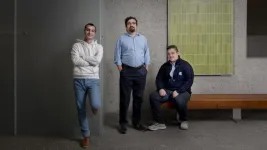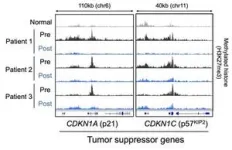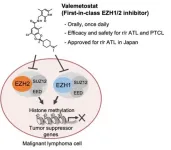(Press-News.org) In the blink of an eye, the unruly, superheated plasma that drives a fusion reaction can lose its stability and escape the strong magnetic fields confining it within the donut-shaped fusion reactor. These getaways frequently spell the end of the reaction, posing a core challenge to developing fusion as a non-polluting, virtually limitless energy source.
But a Princeton-led team composed of engineers, physicists, and data scientists from the University and the Princeton Plasma Physics Laboratory (PPPL) have harnessed the power of artificial intelligence to predict — and then avoid — the formation of a specific plasma problem in real time.
In experiments at the DIII-D National Fusion Facility in San Diego, the researchers demonstrated their model, trained only on past experimental data, could forecast potential plasma instabilities known as tearing mode instabilities up to 300 milliseconds in advance. While that leaves no more than enough time for a slow blink in humans, it was plenty of time for the AI controller to change certain operating parameters to avoid what would have developed into a tear within the plasma’s magnetic field lines, upsetting its equilibrium and opening the door for a reaction-ending escape.
“By learning from past experiments, rather than incorporating information from physics-based models, the AI could develop a final control policy that supported a stable, high-powered plasma regime in real time, at a real reactor,” said research leader Egemen Kolemen, associate professor of mechanical and aerospace engineering and the Andlinger Center for Energy and the Environment, as well as staff research physicist at PPPL.
The research opens the door for more dynamic control of a fusion reaction than current approaches, and it provides a foundation for using artificial intelligence to solve a broad range of plasma instabilities, which have long been obstacles to achieving a sustained fusion reaction. The team published their findings in Nature on February 21.
“Previous studies have generally focused on either suppressing or mitigating the effects of these tearing instabilities after they occur in the plasma,” said first author Jaemin Seo, an assistant professor of physics at Chung-Ang University in South Korea who performed much of the work while a postdoctoral researcher in Kolemen’s group. “But our approach allows us to predict and avoid those instabilities before they ever appear.”
Superheated plasma swirling in a donut-shaped device
Fusion takes place when two atoms — usually light atoms like hydrogen — come together to form one heavier atom, releasing a large amount of energy in the process. The process powers the Sun, and, by extension, makes life on Earth possible.
However, getting the two atoms to fuse is tricky, as it takes massive amounts of pressure and energy for the two atoms to overcome their mutual repulsion.
Fortunately for the Sun, its massive gravitational pull and extremely high pressures at its core allow fusion reactions to proceed. To replicate a similar process on the Earth, scientists instead use extremely hot plasma and extremely strong magnets.
In donut-shaped devices known as tokamaks — sometimes referred to as “stars in jars” — magnetic fields struggle to contain plasmas that reach above 100 million degrees Celsius, hotter than the center of the Sun.
While there are many types of plasma instabilities that can terminate the reaction, the Princeton team concentrated on solving tearing mode instabilities, a disturbance in which the magnetic field lines within a plasma actually break and create an opportunity for the plasma’s subsequent escape.
“Tearing mode instabilities are one of the major causes of plasma disruption, and they will become even more prominent as we try to run fusion reactions at the high powers required to produce enough energy,” said Seo. “They are an important challenge for us to solve.”
Fusing artificial intelligence and plasma physics
Since tearing mode instabilities can form and derail a fusion reaction in milliseconds, the researchers turned to artificial intelligence for its ability to quickly process and act in response to new data.
But the process to develop an effective AI controller was not as simple as trying out a few things on a tokamak, where time is limited, and the stakes are high.
Co-author Azarakhsh Jalalvand, a research scholar in Kolemen’s group, compared teaching an algorithm to run a fusion reaction in a tokamak to teaching someone how to fly a plane.
“You wouldn’t teach someone by handing them a set of keys and telling them to try their best,” Jalalvand said. “Instead, you’d have them practice on a very intricate flight simulator until they’ve learned enough to try out the real thing.”
Like developing a flight simulator, the Princeton team used data from past experiments at the DIII-D tokamak to construct a deep neural network capable of predicting the likelihood of a future tearing instability based on real-time plasma characteristics.
They used that neural network to train a reinforcement learning algorithm. Like a pilot trainee, the reinforcement learning algorithm could try out different strategies for controlling plasma, learning through trial and error which strategies worked and which did not within the safety of a simulated environment.
“We don’t teach the reinforcement learning model all of the complex physics of a fusion reaction,” Jalalvand said. “We tell it what the goal is — to maintain a high-powered reaction — what to avoid — a tearing mode instability — and the knobs it can turn to achieve those outcomes. Over time, it learns the optimal pathway for achieving the goal of high power while avoiding the punishment of an instability.”
While the model went through countless simulated fusion experiments, trying to find ways to maintain high power levels while avoiding instabilities, co-author SangKyeun Kim could observe and refine its actions.
“In the background, we can see the intentions of the model,” said Kim, a staff research scientist at PPPL and former postdoctoral researcher in Kolemen’s group. "Some of the chnges that the model wants are too rapid, so we work to smooth and calm the model. As humans, we arbitrate between what the AI wants to do and what the tokamak can accommodate."
Once they were confident in the AI controller’s abilities, they tested it during an actual fusion experiment at the D-III D tokamak, observing as the controller made real-time changes to certain tokamak parameters to avoid the onset of an instability. These parameters included changing the shape of the plasma and the strength of the beams inputting power into the reaction.
“Being able to predict instabilities ahead of time can make it easier to run these reactions than current approaches, which are more passive,” said Kim. “We no longer have to wait for the instabilities to occur and then take quick corrective action before the plasma becomes disrupted.”
Powering into the future
While the researchers said the work is a promising proof-of-concept demonstrating how artificial intelligence can effectively control fusion reactions, it is only one of many next steps already ongoing in Kolemen’s group to advance the field of fusion research.
The first step is to get more evidence of the AI controller in action at the DIII-D tokamak, and then expand the controller to function at other tokamaks.
“We have strong evidence that the controller works quite well at DIII-D, but we need more data to show that it can work in a number of different situations,” said first author Seo. “We want to work toward something more universal.”
A second line of research involves expanding the algorithm to handle many different control problems at the same time. While the current model uses a limited number of diagnostics to avoid one specific type of instability, the researchers could provide data on other types of instabilities and give access to more knobs for the AI controller to tune.
“You could imagine one large reward function that turns many different knobs to simultaneously control for several types of instabilities,” said co-author Ricardo Shousha, a postdoc at PPPL and former graduate student in Kolemen’s group who provided support for the experiments at DIII-D.
And on the route to developing better AI controllers for fusion reactions, researchers might also gain more understanding of the underlying physics. By studying the AI controller’s decisions as it attempts to contain the plasma, which can be radically different than what traditional approaches might prescribe, artificial intelligence may be not only a tool to control fusion reactions but also a teaching resource.
“Eventually, it may be more than just a one-way interaction of scientists developing and deploying these AI models,” said Kolemen. “By studying them in more detail, they may have certain things that they can teach us too.”
The paper, “Avoiding tokamak tearing instability with artificial intelligence,” was published February 21 in Nature. In addition to Kolemen, Seo, Jalalvand, Kim, and Shousha, co-authors include Rory Conlin, Joseph Abbate and Josiah Wai of Princeton University, as well as Keith Erickson of PPPL.
The work was supported by the U.S. Department of Energy’s Office of Fusion Energy Sciences, as well as the National Research Foundation of Korea (NRF). The authors also acknowledge the use of the DIII-D National Fusion Facility, a Department of Energy Office of Science user facility.
END
Engineers use AI to wrangle fusion power for the grid
2024-02-21
ELSE PRESS RELEASES FROM THIS DATE:
UChicago scientists invent ultra-thin, minimally-invasive pacemaker controlled by light
2024-02-21
Sometimes our bodies need a boost. Millions of Americans rely on pacemakers—small devices that regulate the electrical impulses of the heart in order to keep it beating smoothly. But to reduce complications, researchers would like to make these devices even smaller and less intrusive.
A team of researchers with the University of Chicago has developed a wireless device, powered by light, that can be implanted to regulate cardiovascular or neural activity in the body. The featherlight membranes, ...
Accelerometer-measured physical activity, sedentary time, and heart failure risk in older women
2024-02-21
About The Study: The results of this study of 5,951 women ages 63 to 99 suggest that promoting regular physical activity and minimal sedentary time may be prudent for primary prevention of heart failure and its subtype with preserved ejection fraction for which treatment is limited.
Authors: Michael J. LaMonte, Ph.D., M.P.H., of the University at Buffalo—SUNY, is the corresponding author.
To access the embargoed study: Visit our For The Media website at this link https://media.jamanetwork.com/
(doi:10.1001/jamacardio.2023.5692)
Editor’s Note: Please see the article for additional information, including other ...
Lifetime suicide attempts in otherwise psychiatrically healthy individuals
2024-02-21
About The Study: In this study using data from 1,948 U.S. adults with lifetime suicide attempts from a nationally representative population-based survey, an estimated 19.6% reported not having met criteria for any psychiatric disorders prior to their first attempt. This finding challenges clinical notions of who is at risk for suicidal behavior and raises questions about the safety of limiting suicide risk screening to psychiatric populations.
Authors: Maria A. Oquendo, M.D., Ph.D., of the University of Pennsylvania in Philadelphia, is the corresponding author.
To access the embargoed study: Visit our For The Media ...
Acupuncture for combat-related posttraumatic stress disorder
2024-02-21
About The Study: The acupuncture intervention used in this randomized clinical trial including 93 participants was clinically efficacious and favorably affected the psychobiology of posttraumatic stress disorder (PTSD) in combat veterans. These data build on extant literature and suggest that clinical implementation of acupuncture for PTSD, along with further research about comparative efficacy, durability, and mechanisms of effects, is warranted.
Authors: Michael Hollifield, M.D., of the Tibor Rubin VA Medical Center in Long Beach, California, is the corresponding author.
To access the embargoed study: Visit our For The Media website at this link https://media.jamanetwork.com/
(10.1001/jamapsychiatry.2023.5651)
Editor’s ...
Study finds high number of persistent COVID-19 infections in the general population
2024-02-21
New study finds that persistent COVID-19 infections are surprisingly common, with around one to three in every 100 infections lasting a month or longer.
Some persistent infections had a high number of mutations, suggesting they could act as reservoirs to seed new variants of concern.
People with persistent infections lasting for 30 days or longer were 55% more likely to report having Long Covid than people with more typical infections.
Reinfections with the same variant were rare.
A new study led by the University of Oxford has ...
Researchers reveal mechanism of drug reactivating tumor suppressors
2024-02-21
Researchers have revealed the mechanism of a drug shown to be effective in treating certain types of cancer, which targets a protein modification silencing the expression of multiple tumor suppressor genes. They also demonstrated in clinical trials the efficacy of the drug in reducing tumor growth in blood cancer. The findings could lead to longer-term treatments for the disease and therapies for other types of cancer with similar underlying causes.
A team of researchers from the University of Tokyo and their collaborators focused on therapies targeting H3K27me3, a modification on a DNA-packaging histone protein, which plays a large role in regulating ...
UNC Lineberger named as a national research hub for NIH cancer screening study
2024-02-21
CHAPEL HILL, NC – UNC Lineberger Comprehensive Cancer Center has been selected as one of nine national research sites for the National Cancer Institute’s (NCI), part of the National Institutes of Health, newly launched Cancer Screening Research Network (CSRN), which will evaluate promising and emerging cancer screening technologies.
Supporting the Biden-Harris Administration’s Cancer Moonshot initiative, the CSRN will conduct large, multi-center cancer screening studies with diverse populations in a variety of healthcare settings. The studies are designed to identify ...
New study suggests target steps per day for reduced risk of heart failure
2024-02-21
BUFFALO, N.Y. – The science is clear that movement is good for our bodies as we age. But just how much physical activity is beneficial for people over 60? A new study from the University at Buffalo provides an answer, and it’s not 10,000 steps per day.
In fact, the study — published Feb. 21 in JAMA Cardiology — of nearly 6,000 U.S. women aged 63-99 reports that, on average, 3,600 steps per day at a normal pace was associated with a 26% lower risk of developing heart failure.
The observational study from the Women’s Health Initiative ...
NIH launches research network to evaluate emerging cancer screening technologies
2024-02-21
The National Institutes of Health (NIH) has launched a clinical trials network to evaluate emerging technologies for cancer screening. The Cancer Screening Research Network (CSRN) will support the Biden-Harris administration’s Cancer Moonshot℠ by investigating how to identify cancers earlier, when they may be easier to treat. Eight groups have received funding from the National Cancer Institute (NCI), part of NIH, to carry out the initial activities of the network.
“There are many cancers we still cannot reliably ...
Evidence review: Maternal mental conditions drive climbing death rate in U.S.
2024-02-21
WASHINGTON (Feb. 21, 2024) – Painting a sobering picture, a research team led by Children’s National Hospital culled years of data demonstrating that maternal mental illness is an under-recognized contributor to the death of new mothers. They are calling for urgent action to address this public health crisis in the latest edition of JAMA Psychiatry.
Backed by dozens of peer-reviewed studies and health policy sources, the journal’s special communication comes as maternal mortality soars ...




